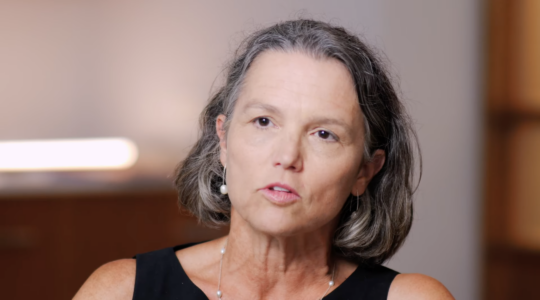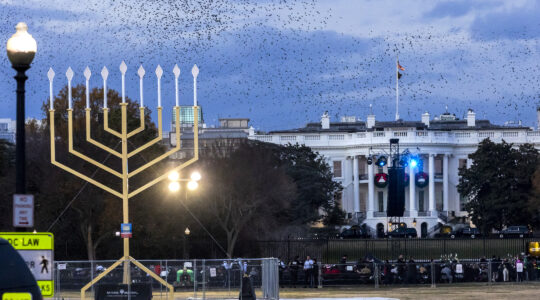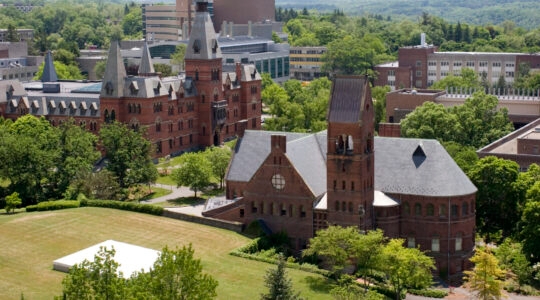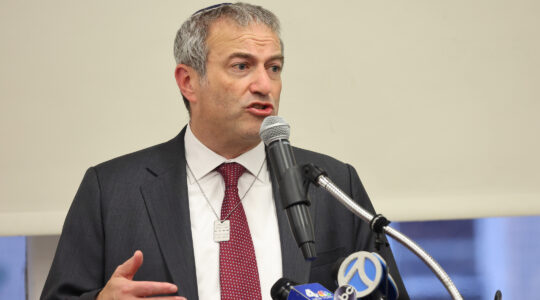
Without a national Jewish population study, finding how many Jews are marrying out of the faith will be difficult. The Marc Mezvinsky-Chelsea Clinton wedding seen here, from July 31, 2010, was one of the more notable interfaith weddings last year. (Genevieve de Manio)
NEW YORK (JTA) — Twenty years ago, an alarming statistic in a landmark survey of American Jews helped galvanize a generation of Jewish community professionals and philanthropists to change the way they think about Jewish identity programming and double their efforts at Jewish outreach.
With time, however, that statistic from the 1990 National Jewish Population Survey — that American Jews were marrying out of the faith at a rate of 52 percent — was clouded by skepticism. Demographers said the actual rate of intermarriage in the period studied was lower — 43 percent — and that in any case the figure didn’t really mean much since it did not account for the much larger number of already existing marriages between Jews.
A decade later, the next national study was beset by greater problems. Data from the NJPS 2000-01 were lost, results were severely delayed and true comparisons with 1990 were impossible, many scholars said, because the methodology used was inconsistent with the earlier survey. On top of everything, the study cost a cool $6 million.
So perhaps it wasn’t terribly surprising that as the date approached for the next decennial survey, which would have come out about now, the federation umbrella organization that owns the NJPS franchise balked.
"We decided not to be the lead agency on a new study, but we haven’t ruled out partnering or sitting at the table with others who are leading a study under the right circumstances," Joe Berkofsky, a spokesman for the Jewish Federations of North America, told JTA. "NJPS was very useful for the Jewish community at large, but given limited resources we decided to focus on research that would directly benefit federations."
For the time being, there is no collaborative national study to take its place. That has dismayed many scholars of American Jewry, including vocal critics of the last study and those who helped carry it out.
"We really can’t get a national portrait from one decade to another and get real insight on regional differences," said sociologist Steven M. Cohen, who was a paid research consultant for the 2000-01 NJPS and is now a professor of Jewish social policy at Hebrew Union College-Jewish Institute of Religion. "We really can’t establish national standards and a national message. We don’t have comparable data across the entire country."
Communities are still carrying out local studies, many with about the same regularity as the NJPS. And for the most part it is local federations that are footing the bill — they are interested in data about population, community characteristics and individual practices to better tailor their fundraising and programming. In New York, the local federation is currently carrying out a $1.8 million study that it is billing as the single-largest community survey of Jews outside Israel.
But without a national study that asks everybody the same questions and surveys all kinds of Jews — from urban to rural, affiliated to assimilated, young to old — it’s not really possible to establish a national picture. Nor is it possible to come up with the holy grail that everyone from political strategists to community professionals want from a national survey: a reliable estimate of the number of Jews in America.
Some scholars say that elusive number — current estimates range from about 5 million to 7 million — can never reliably be established, even if everyone could agree on what makes someone a Jew.
"After spending tens of millions of dollars, we don’t know and we really never will know," said Ira Sheskin, a director of the Jewish Demography Project at the University of Miami, who has done dozens of population studies for Jewish communities throughout the United States.
A few problems make surveying American Jews so difficult.
First, the U.S. Census is prohibited from asking about religion, so there is no easy shortcut. Second, because Jews are thought to comprise only about 2 percent of the U.S. population of 310 million, they are nearly impossible to find using the gold standard for polling: random digit dialing. Assuming that approximately 4 percent of U.S. households have a Jewish person in residence, it would take pollsters using this method about 100,000 phone calls to come up with a credible sample size of 4,000 Jews, and there is no guarantee most of those Jews would agree to participate in a survey.
Even if labor and cost were not an issue, the method of random digit dialing is becoming less reliable in the age of cell phones. Individuals who don’t have land-line telephones tend to be underrepresented because they have fewer opportunities to be reached and are less likely to agree to be interviewed on their cell phones, skewing the sample size away from poorer and younger people who eschew land lines.
The surveys also have a harder time finding data by region because Americans now often keep their mobile numbers even when they move to a different part of the country. Calling someone with a 202 area code may get you someone who lives in Washington — or California.
For demographers seeking other ways to find Jews, focusing on areas where Jews are known to live risks undercounting those who are harder to find. By the same token, relying on membership lists maintained by federations, schools, JCCs or synagogues to conduct interviews risks undercounting the unaffiliated.
Some of these problems also plague local community studies. But because the sample sizes are smaller and the goals are different, many community surveyors don’t care or are able to find other ways to get the data they require.
Leonard Saxe, director of the Steinhardt Social Research Institute at Brandeis University, says he has found a way around these problems for national data and, using complicated mathematical modeling, offers an estimate of self-identified Jews in the United States: 6.5 million. Of course, other academics have questions about Saxe’s conclusions.
"The fact that UJC isn’t sponsoring a study doesn’t mean that the community won’t have data," Saxe said, using the obsolete name of the Jewish Federations of North America (once known as the United Jewish Communities). "My goal is to provide better data and more accurate data. The methodology that was used in 2000 provided inaccurate and, we believe, misleading results."
The lead researcher for the national federation organization, Laurence Kotler-Berkowitz, was traveling and unavailable for interviews, a federation spokesman said.
Cohen says that while he understands that cost and controversy kept the Jewish Federations of North America from doing another national study, the absence of any national study is a great loss for the Jewish community and one that local studies — as helpful as they are — cannot fill.
"People are worried that if you do a study there will be controversy, and there will be. But the value outweighs the controversy," he said. "We don’t have a sense of the problems and potential. We’ve lost an instrument to help build community. That’s definitely regrettable."
JTA has documented Jewish history in real-time for over a century. Keep our journalism strong by joining us in supporting independent, award-winning reporting.





